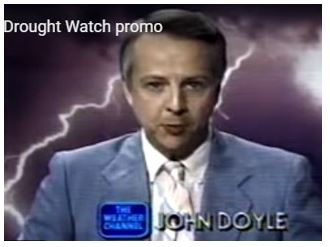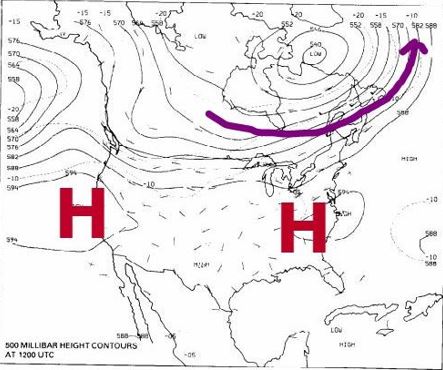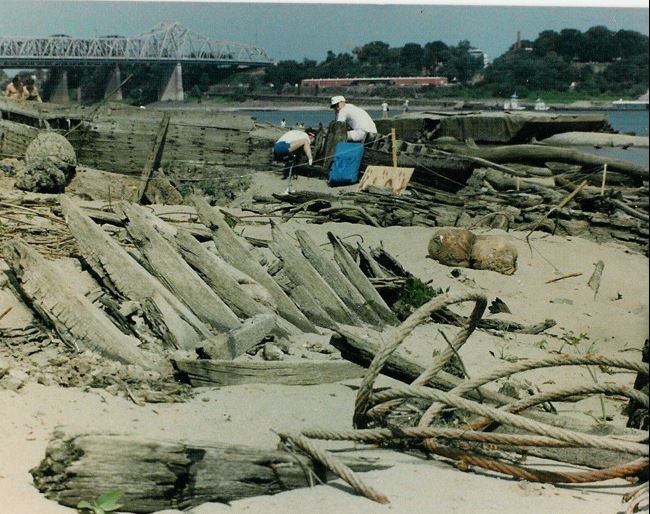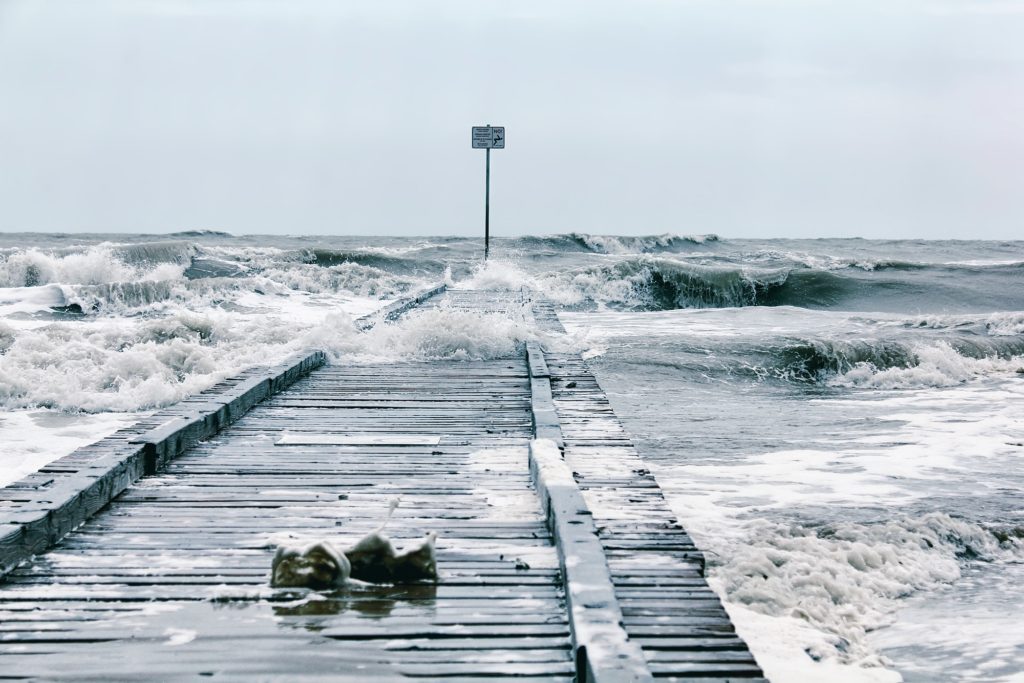In the summer of 1988 I was an On-Camera Meteorologist at The Weather Channel. The dominating weather event that summer was an intense and expansive drought which produced billons of dollars of damage from ruined crops and it took thousands of lives. At The Weather Channel, we devoted an entire day to a “Drought Symposium” where several invited experts made presentations covering all aspects of monumental event ! We televised the conference from the Cobb Galleria Center on the northwest side of Atlanta. Yes, this is the same facility where some of the recent MLB All-Star Game activities just concluded .
Drought Ingredients
One of the main factors that led to the drought was La Niña conditions in the eastern Pacific. Atmospheric conditions, conducive to drought, had already begun in March of 1988. The Intertropical Convergence Zone in the eastern Pacific shifted.
There were unusually high levels of outgoing long wave radiation over the Gulf of Mexico, the southeastern United States, and northeastern South America. Scientists have observed similar anomalies in outgoing longwave radiation in the majority of major drought events in North America.
Prevailing winds in the Spring of 1988 were from dry desert areas rather than from the Gulf of Mexico. The overall dry conditions became apparent by the end of April. By early June, the entire Great Plains region of the U.S. had received less than one half of their average precipitation.
By then the dryness has spread into the Corn Belt. From March to May, Des Moines, Iowa had only received 30 percent of their average precipitation. Intense heat accompanied the drought at times ! By early June, many locations from the Canadian border to Texas had received less than 50% of normal precipitation, with some areas getting less than 40%.
Summer of Drought and Heat
As 1988 moved into summer the drought began to feed on itself. A massive ridge of high pressure aloft dominated much of the U.S. and its effects were widespread. Under the dome of high pressure, the air sinks and warms which makes temperatures high and clouds difficult to form or develop.
Areas of low pressure and their attending fronts were shunted far to the north. Soil moisture was low, so there was little evaporation for afternoon thunderstorms.
The peak of the heat and drought began around the 8th and 9th of July. An upper-level atmospheric chart is shown below.
A 500 millibar chart from mid-July of 1988 shows massive ridges of high pressure across much of the U.S. with the jet stream/storm track far to the north. Map Credit-NWS.
1988 – Twenty-three cities in the eastern U.S. reported record high temperatures for the date. Alpena, MI, and Buffalo, NY, suffered through their sixth straight day of record heat. The percentage of the total area in the country in the grips of severe to extreme drought reached 43 percent, the fourth highest total of record. The record of 61 percent occurred during the summer of 1934. (The National Weather Summary).
Here is a Drought Severity Map that appeared on The Weather Channel on July 11, 1988.
 A Drought Severity Map that was shown on The Weather Channel on July 11, 1988. Photo credit- TWC on YouTube. The event extended through July.
A Drought Severity Map that was shown on The Weather Channel on July 11, 1988. Photo credit- TWC on YouTube. The event extended through July.
1988 – Twenty-six cities east of the Mississippi River reported record high temperatures for the date. Charleston, WV, established an all-time record high. with a reading of 103 degrees, and Chicago, IL, reported a record fifth day of 100-degree heat for the year.
High temperatures in Valentine, Nebraska, and Sioux Falls, South Dakota recorded highs of 100 degrees. It was even hotter on July 16th.
1988 – Thirty-seven cities in the eastern U.S. reported record high temperatures for the date. Highs of 96 degrees at Bluefield, WV, and 104 degrees at Charleston WV were all-time records, and afternoon highs of 98 degrees at Binghamton, NY, 99 degrees at Elkins, WV, and 103 degrees at Pittsburgh PA, tied all-time records. Highs of 104 degrees at Baltimore, MD, and 105 degrees at Parkersburg WV were records for July, and Beckley, WV, equaled their record for July with a high of 94 degrees. Martinsburg, WV, was the hot spot in the nation with a reading of 107 degrees.
Pittsburgh, Pennsylvania recorded 15 consecutive days when the mercury rose to 90 degrees or higher. Chicago, Illinois, reported 47 days with high temperatures of 90 degrees or higher that summer.
The heat and drought expanded into the Southeast. I remember moving into a new house northwest of Atlanta, Georgia, and from the last week of June through the first week of August we never saw a drop of rain. My new lawn was ruined as were many others across a significant number of states.
It was becoming quite apparent that there would be massive crop failures. The number of fatalities from heat stress continued to rise. The drought and heat were making national news and the story would last for quite some time.
Media Coverage – The Weather Channel “Drought Watch”
The weather was suddenly becoming a major news item during the summer of 1988. Heat and drought, rather than the usual severe thunderstorms, became the main story.
Each night on the major news networks, this weather would of often take the lead. I was with The Weather Channel at the time, and we decided to put major emphasis on this topic. We began by interjecting drought updates into our regular on-air segments.
That didn’t seem to be enough, however, and it was finally decided that we would produce an hour show which would be called “Drought Watch” and it would appear several times a week. The show would include the main anchor and guest meteorologists, climatologists, government officials, agriculture and water management experts, etc. Calls from viewers would also be taken.
At that time, pulling off something like this was quite a chore for us, with our limited resources. We had to broadcast from an alternate studio. There were long electrical cords and phone lines extending out of the room.
After about a month, we were running out of expert guests to bring in so we used some of our own Meteorologists and On-Camera Meteorologists as guests. I remember being a guest on four different occasions. It got to the point where the questions often strayed from the topic so we pulled the plug on the program. I did find a promo that we ran on TWC with one of our anchors. John Doyle (see below).
An image of The Weather Channel promo for their Drought Watch show, with anchor John Doyle, that was broadcast during the summer of 1988. Image Credit- TWC on YouTube.
As for the “Drought Symposium”, mentioned earlier, we invited meteorologists, college professors, and other experts to engage in a discussion, plus questions and answers. the event was televised on TWC but I can’t find any information about it or any footage. The event was held at a hotel in the Galleria Complex in Cobb County, Georgia. I do remember attending the event, however.
Impacts
The 1988 drought was the worst since the “Dust Bowl” days of the 1930s. The total cost of damages inflicted on agriculture and related industries totaled around 70 billion dollars (over 190 billion in 2025 dollars). Overall damage across the U.S. was probably double that amount.
The death toll from the relentless heat in the central and eastern U.S. was estimated to be from 5,000 to 10,000.
 This photo shows a Wisconsin farmer evaluating his struggling corn crop during the summer of 1988. Photo Credit-L Roger Tuner-Wisconsin State Journal Archives.
This photo shows a Wisconsin farmer evaluating his struggling corn crop during the summer of 1988. Photo Credit-L Roger Tuner-Wisconsin State Journal Archives.
Parts of the Mississippi River was reduced to a mere trickle and it was unnavigable. This cost the shipping industry up to one billion dollars. There were sandbars all over the river and long forgotten shipwrecks were exposed.
The photo shoes exposed hulls of ships along the Mississippi River at Memphis, Tennessee, during the summer of 1988. Image Credit-Wikipedia-Public Domain
At its peak, about 45 percent of the nation was experiencing drought or severe drought conditions.
In the northern Rockies, the Yellowstone Fires collectively formed the largest wildfire in the recorded history of Yellowstone National Park.
Initially, there were many small fires but flames quickly spread out of control due to the drought and increasing winds and became one massive fire. The fire almost destroyed two major visitors centers and, on September 8, 1988, the entire park closed to all non-emergency personnel for the first time in its history.
 The photo shows res seen from the Old Faithful Complex at Yellowstone National Park in the summer of 1988. Photo Credit-Wikipedia-Public Domain.
The photo shows res seen from the Old Faithful Complex at Yellowstone National Park in the summer of 1988. Photo Credit-Wikipedia-Public Domain.
Fortunately, the drought began to show some cracks in September as the upper-level weather pattern began to change a bit. Rain from Hurricane Gilbert moved up from Mexico to Texas and the southern Plains and into the Midwest and Great Lakes later in the month.
It was not nearly enough, however, and major damage had already been done. Further details and graphical representations of the 1988 drought can be found in the NOAA Institutional Repository’s document titled “The drought of 1988 and beyond. Hopefully, events of this magnitude will be few and far between !




